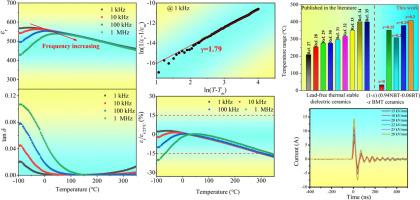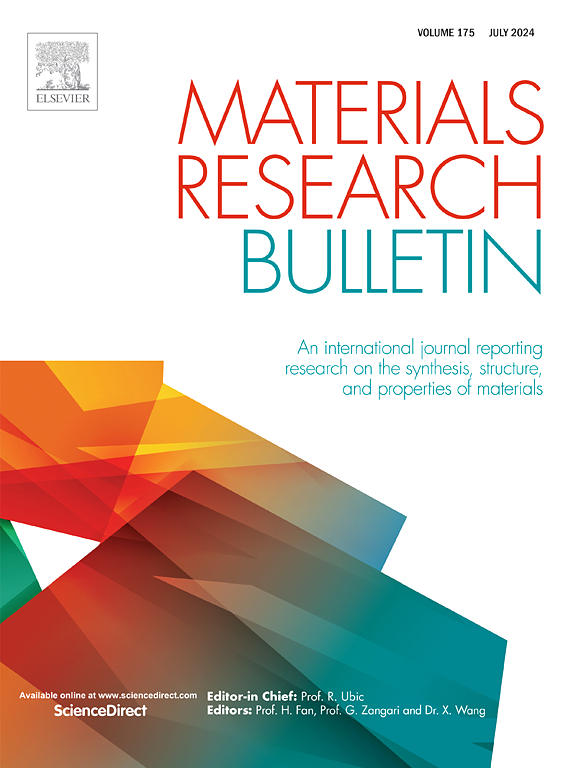Superior dielectric temperature stability and high energy-storage density of ecologically friendly 0.7(0.94Bi0.5Na0.5TiO3–0.06BaTiO3)-0.3Ba(Mg1/3Ta2/3)O3 ceramics
IF 5.3
3区 材料科学
Q2 MATERIALS SCIENCE, MULTIDISCIPLINARY
引用次数: 0
Abstract
Recently, much attention has been given to dielectric ceramic capacitors, which have excellent temperature stability and a high energy-storage density. Ecologically friendly ceramics ((1-x)(0.94Bi0.5Na0.5TiO3–0.06BaTiO3)-xBa(Mg1/3Ta2/3)O3, where x = 0, 0.15, 0.2, 0.25, or 0.3) were synthesised using a conventional solid-state method. The ceramic sample with x = 0.3 exhibited a superior dielectric temperature stability, relative permittivity that varied within ±15%, and low dielectric loss of less than 0.02 over a temperature range of −100 to +307 °C, which met the X9R specifications. In addition, a scanning electron microscopy image confirmed that the sample had a dense and uniform microstructure. Furthermore, a high recoverable energy-storage density of 6.75 J/cm3 was obtained for the ceramic sample with x = 0.3 under a moderate applied electric field of 420 kV/cm. These characteristics suggest that it is a promising candidate for an ecologically friendly temperature-insensitive dielectric ceramic for energy-storage capacitors.

生态友好型 0.7(0.94Bi0.5Na0.5TiO3-0.06BaTiO3)-0.3Ba(Mg1/3Ta2/3)O3 陶瓷的卓越介电温度稳定性和高储能密度
最近,介电陶瓷电容器备受关注,因为它具有出色的温度稳定性和较高的能量存储密度。采用传统固态方法合成了生态友好型陶瓷((1-x)(0.94Bi0.5Na0.5TiO3-0.06BaTiO3)-xBa(Mg1/3Ta2/3)O3,其中 x = 0、0.15、0.2、0.25 或 0.3)。x = 0.3 的陶瓷样品具有优异的介电温度稳定性,相对介电系数变化范围在 ±15% 以内,在 -100 至 +307 °C 的温度范围内介电损耗小于 0.02,符合 X9R 规范。此外,扫描电子显微镜图像证实,样品具有致密均匀的微观结构。此外,在 420 kV/cm 的中等应用电场下,x = 0.3 的陶瓷样品获得了 6.75 J/cm3 的高可回收储能密度。这些特性表明,它有望成为用于储能电容器的生态友好型温度不敏感介电陶瓷。
本文章由计算机程序翻译,如有差异,请以英文原文为准。
求助全文
约1分钟内获得全文
求助全文
来源期刊

Materials Research Bulletin
工程技术-材料科学:综合
CiteScore
9.80
自引率
5.60%
发文量
372
审稿时长
42 days
期刊介绍:
Materials Research Bulletin is an international journal reporting high-impact research on processing-structure-property relationships in functional materials and nanomaterials with interesting electronic, magnetic, optical, thermal, mechanical or catalytic properties. Papers purely on thermodynamics or theoretical calculations (e.g., density functional theory) do not fall within the scope of the journal unless they also demonstrate a clear link to physical properties. Topics covered include functional materials (e.g., dielectrics, pyroelectrics, piezoelectrics, ferroelectrics, relaxors, thermoelectrics, etc.); electrochemistry and solid-state ionics (e.g., photovoltaics, batteries, sensors, and fuel cells); nanomaterials, graphene, and nanocomposites; luminescence and photocatalysis; crystal-structure and defect-structure analysis; novel electronics; non-crystalline solids; flexible electronics; protein-material interactions; and polymeric ion-exchange membranes.
 求助内容:
求助内容: 应助结果提醒方式:
应助结果提醒方式:


